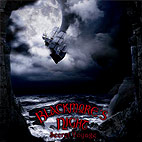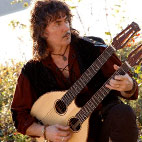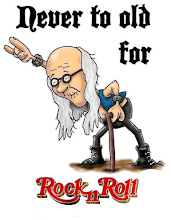 Go into any random music store and there always seems to be that one guitarist laying down what could be considered one of the most famous riffs of all time: the intro to "Smoke On The Water." It’s a riff that has resonated with fans over 35 years and played a large role in propelling Deep Purple guitarist Ritchie Blackmore to icon status. Surprisingly, it was only a few years after Blackmore wrote that song when he started to show subtle signs (at least to his bandmates) that his musical tastes might be changing. In the early days of another successful project, Rainbow, Blackmore would frequently start practicing compositions from a genre that was a far cry from rock – Renaissance folk. It wasn’t until 1997 that Blackmore’s passion for the Renaissance would finally take center stage in his life. With the help of his longtime love Candice Night, the guitarist created Blackmore’s Night, which not only took on traditional compositions from the 1500s, but also injected classic Rainbow tracks with a touch of the Renaissance. On June 15 Blackmore’s Night released its 7th studio release Secret Voyage, an album filled with intricate acoustic work and a twist on the Rainbow classic "Rainbow Eyes." Ultimate-Guitar recently was fortunate enough to conduct an interview via email with Ritchie Blackmore, who discussed the latest album and how his passion for Renaissance music developed over the years.
Go into any random music store and there always seems to be that one guitarist laying down what could be considered one of the most famous riffs of all time: the intro to "Smoke On The Water." It’s a riff that has resonated with fans over 35 years and played a large role in propelling Deep Purple guitarist Ritchie Blackmore to icon status. Surprisingly, it was only a few years after Blackmore wrote that song when he started to show subtle signs (at least to his bandmates) that his musical tastes might be changing. In the early days of another successful project, Rainbow, Blackmore would frequently start practicing compositions from a genre that was a far cry from rock – Renaissance folk. It wasn’t until 1997 that Blackmore’s passion for the Renaissance would finally take center stage in his life. With the help of his longtime love Candice Night, the guitarist created Blackmore’s Night, which not only took on traditional compositions from the 1500s, but also injected classic Rainbow tracks with a touch of the Renaissance. On June 15 Blackmore’s Night released its 7th studio release Secret Voyage, an album filled with intricate acoustic work and a twist on the Rainbow classic "Rainbow Eyes." Ultimate-Guitar recently was fortunate enough to conduct an interview via email with Ritchie Blackmore, who discussed the latest album and how his passion for Renaissance music developed over the years. UG: How far back does your interest in Renaissance-influenced music go?
Ritchie Blackmore: 1972, when I first heard David Munrow and the Early Music Consort of London. Obviously, being English, I was exposed to Renaissance music as I was growing up – albeit subliminal, probably from the radio.
Was there ever a time in Rainbow or Deep Purple when you would approach your bandmates with ideas that are similar to something we hear in Blackmore’s Night?
Yes, I used to drive them nuts playing the theme to what is now “Renaissance Faire” back in 1976.
 |
| "I usually end up by not being too impressed by what I’ve played." |
No. We always approach it the same. We have our producer arrive from LA, we go out, get drunk, come back, go downstairs in the dungeon to our home studio, lay down some tracks. I always start by laying down the guitar first, with Candice doing a guide vocal. Then Pat learns his part that we gave him. We progress from there.
Would you say that you consistently collaborate with Candice on every song?
Yes, even instrumentals. Sometimes I ask her (if) I don’t know if it’s a good or bad instrumental, and sometimes I need an opinion to if it’s worth recording. Sometimes she’ll remind me that I played the same notes in another song which I’ve forgotten about.
Can you give us an idea of what kind of guitars and mandolins we’re hearing on Secret Voyage?
I have mandolas made by an English company called Fylde; a nickelharpe (not very well) from Germany; I play a mandolin from Fender; hurdy gurdy by Helmut Gotsky; a Hideho Kawakami semi acoustic; a Lakewood acoustic, an Alvarez acoustic and of course, the Fender Strat and a Gretsch Firebird on 1 track.
Did you try out anything new in terms of the equipment?
First time playing nickelharpe.
You revisit the Rainbow classic “Rainbow Eyes.” Because you’re already so familiar with the song, did you already have a firm idea of how you would rearrange the composition to fit Blackmore’s Night?
Candice and I had sung it many times to our friends at parties and they all loved it so we thought we’d put it on. The arrangement just fell into place. I was torn between the acoustic and electric and wound up with the electric. On stage we do it acoustically.
The acoustic work on “Prince Waldeck’s Galliard” is simply amazing. How long did it take you to arrange that composition?
Very quick. It was just something I put together pretty quickly. Thanks for the compliment. It just reminded me, as I was playing, of the dances back in the Renaissance times. We actually tried accompanying the guitar with other instruments, but it didn’t sound right so we just left the guitar to stand on its own.
Are you primarily fingerpicking during the entire album?
Yes, unless I’m playing electric guitar – which incidentally, takes me a good 15 minutes to get accustomed to the plectrum style again.
Would you consider yourself a perfectionist in the studio?
Absolutely not. I usually end up by not being too impressed by what I’ve played – but I hate to spend more than 15 minutes in the studio. The studio always gives me the creeps. It reminds me too much of being in a classroom at school. Much too sterile for me. I’d rather be playing in a wood surrounded by trees, but they haven’t invented a recording tree yet that I know of. Having said that, I’m sure someone will say that they have. I’ve never really played my best in the studio. Sometimes by sheer luck I’ll play something that works.
 |
| "Being English, I was exposed to Renaissance music as I was growing up." |
Yes.
You were such a massive influence as an electric guitarist during your days in Deep Purple and Rainbow. Do you have one or two rock tracks from that time of which you are particularly proud?
I like “Gates of Babylon” by Rainbow and “Stargazer.” By DP I thought “Perfect Strangers” came out well, though I couldn’t play a good solo over it. So I gave the solo to Jon.
How did you originally decide to use a scalloped fingerboard? Do most of your instruments have the scalloped feature?
Yes, they all do. I first came across this idea back in 1966 when I played an old guitar. It was so old the fingerboard was pitted and concave. It felt very natural to me. So years later, when I had the Strat, I sandpapered the wood between the frets down so I’d have more leverage when bending a note. I actually put that idea into use about 1973.
Do you ever see yourself making another rock album?
I don’t know. I like playing heavy rock blues. I still play it to myself. Haven’t gotten around to being in a studio playing hard stuff yet. Maybe next time.
What are some techniques that you found invaluable during your early years as a guitarist?
I have just one technique: It’s my own. I’m not very good at copying other people, never have been.
Interview by Amy Kelly
Ultimate-Guitar.Com © 2008







 Adicionar aos Favoritos
Adicionar aos Favoritos